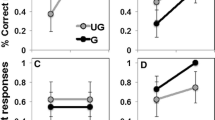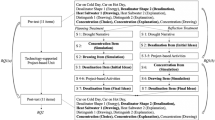Abstract
A study of the effect of science teaching with a multimedia simulation on water quality, the “River of Life,” on the science conceptual understanding of students (N = 83) in an undergraduate science education (K-9) course is reported. Teaching reality-based meaningful science is strongly recommended by the National Science Education Standards (National Research Council, 1996). Water quality provides an information-rich context for relating classroom science to real-world situations impacting the environment, and will help to improve student understanding of science (Kumar, 2005a; Kumar and Chubin, 2000). The topics addressed were classes of organisms that form river ecosystem, dissolved oxygen, macroinvertebrates, composition of air, and graph reading skills. Paired t-test of pre- and post-tests, and pre- and delayed post-tests showed significant (p < 0.05) gains. The simulation had a significant effect on the conceptual understanding of students enrolled in a K-9 science education course for prospective teachers in the following areas: composition of air, macroinvertebrates, dissolved oxygen, classes of organisms that form a river ecosystem, and graph reading skills. The gain was more in the former four areas than the latter one. A paired t-test of pre- and delayed post-tests showed significant (p < 0.05) gains in the water quality and near transfer subsets than the dissolved oxygen subset. Additionally students were able to transfer knowledge acquired from the multimedia simulation on more than one concept into teachable stand-alone lesson plans.





Similar content being viewed by others
References
Allen M. B. (2003) Eight question on teacher preparation: What does the research say?. Denver, CO, Education Commission of the States
Cognition and Technology Group at Vanderbilt. (1993) Anchored instruction and situated cognition revisited. Educational Technology, 33:52–70
Cognition and Technology Group at Vanderbilt. (1992) Anchored instruction in science and mathematics: Theoretical basis, developmental projects, and initial research findings. In: Duschl R., Hamilton R. (eds) Philosophy of science, cognitive psychology and educational theory and practice. New York, SUNY Press
Kumar D. D. (2005a) Sustainability through science-technology-society education. In: Wildrer P. A., Schroeder E. D., Kopp H. (eds) Global sustainability. The impact of local cultures. A new perspective for science, engineering, economics and politics. Weinheim, Wiley - VCH
Kumar, D. D. (2005b). Teaching science with a computer simulation on water quality. A paper presented at the annual meeting of the American Institute of Chemists, Philadelphia, PA
Kumar D. D., Morris J. D. (2005). Predicting scientific understanding of prospective elementary teachers: Role of gender, education level, courses in science, and attitudes toward science and mathematics. Journal of Science Education and Technology, 14(4):387–391
Kumar D. D., Crippen K. J. (2005). Science education in review: Response to secretary’s summit 2004. Journal of Science Education and Technology, 14(2):143–145
Kumar D. D. (2004). Analysis of laptop computers in science. Science Education International, 15(3):201–208
Kumar D.D. (2003). Trends in post-secondary science in the United States. The Annals of the American Academy of Political and Social Science, 585:124–133
Kumar D. D., Altschuld J. W. (2003). Science education policy: A symposium. The Review of Policy Research, 20(4):561–567
Kumar D. D., Chubin, D. E. (Eds.) (2000). Science, technology, & society: A sourcebook on research and practice, New York: Kluwer Academic/Plenum Publishers
Kumar D. D., Sherwood R. D. (1997) Hypermedia in science and mathematics: Applications in teacher education, problem solving and student testing. Journal of Educational Computing Research, 17(3):249–262
Milken Exchange on Education Technology (1999). Will new teachers be prepared to teach in a digital age? A national survey on information technology in teacher education. Author, Santa Monica, CA.
National Commission on Teaching & America’s Future (1996). What matters most: Teaching for America’s future, New York, NY, Author.
National Research Council (1996). National science education standards, National Academy Press, Washington, DC.
Schwartz D. L., Brophy S., Lin X., Bransford J. D. (1999) Software for managing complex learning: Examples from an educational psychology course. Educational Technology Research and Development, 47(2):39–60
Sherwood R. D. (2001). River of Life (Multimedia Program). Nashville, TN, Learning Technology Center, Vanderbilt University
Sherwood R. D. (2002). Problem-Based multimedia software for middle grades science: Development issues and an initial field study. Journal of Computers in Mathematics and Science Teaching, 21(2):147–165
Vye, N. J., Schwartz, D. L., Bransford, J. D., Barron, B. J., Zech, L., and The Cognition and Technology Group at Vanderbilt (CTGV) (1998). SMART environments that support monitoring, reflection, and revison. In D. Hacker, J. Dunlosky, & A.C. Graesser (Eds.), Metacognition in educational theory and practice (pp. 305–346). Lawrence Erlbaum: Mahwah, NJ.
Acknowledgements
The research reported in this paper was supported by a grant from the South Florida Cooperative Ecosystems Studies Unit, National Park Service (J5040-04-0051). The River of Life simulation was developed with funding from the National Science Foundation (ESI-9842439). Thanks to Ms. Jennifer Waldman, Ms. Karen Tobias, Ms. Kim Scarola, Ms. Tiffany OBryan and Mr. Luigi Baroni for assistance with various phases during the project.
Author information
Authors and Affiliations
Corresponding author
Rights and permissions
About this article
Cite this article
Kumar, D.D., Sherwood, R.D. Effect of a Problem Based Simulation on the Conceptual Understanding of Undergraduate Science Education Students. J Sci Educ Technol 16, 239–246 (2007). https://doi.org/10.1007/s10956-007-9049-3
Published:
Issue Date:
DOI: https://doi.org/10.1007/s10956-007-9049-3




